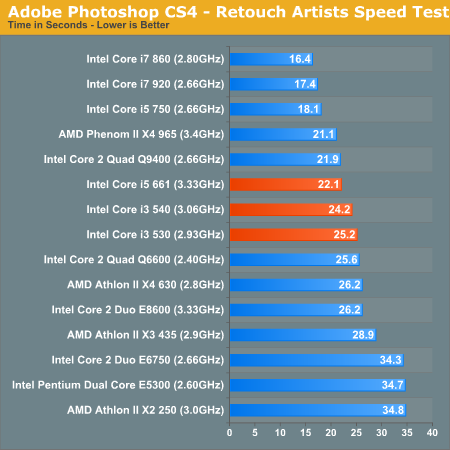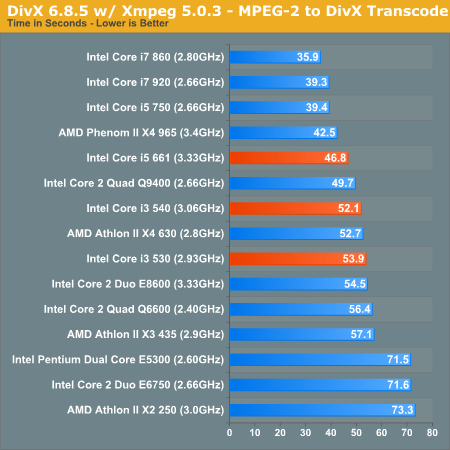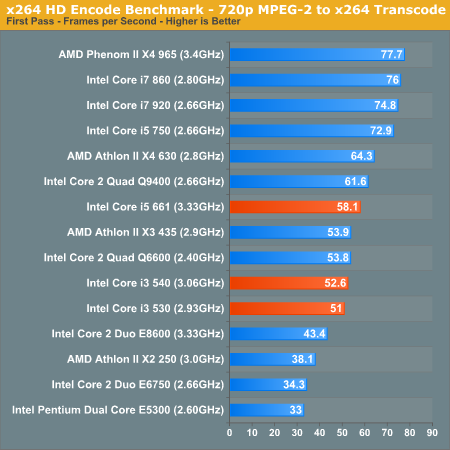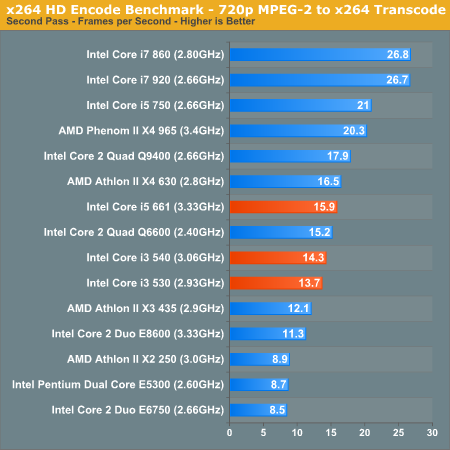The Clarkdale Review: Intel's Core i5 661, i3 540 & i3 530
by Anand Lal Shimpi on January 4, 2010 12:00 AM EST- Posted in
- CPUs
Adobe Photoshop CS4 Performance
To measure performance under Photoshop CS4 we turn to the Retouch Artists’ Speed Test. The test does basic photo editing; there are a couple of color space conversions, many layer creations, color curve adjustment, image and canvas size adjustment, unsharp mask, and finally a gaussian blur performed on the entire image.
The whole process is timed and thanks to the use of Intel's X25-M SSD as our test bed hard drive, performance is far more predictable than back when we used to test on mechanical disks.
Time is reported in seconds and the lower numbers mean better performance. The test is multithreaded and can hit all four cores in a quad-core machine.

And this is where everything changes. While our Photoshop test won't keep four cores busy 100% of the time, it's enough to give the quad-core CPUs an advantage. Here the Core i5 661 is around the speed of a Q9400 but nowhere near the similarly priced Lynnfield Core i5 750.
The Core i3 540/530 are valuable as they are both able to outperform AMD's similarly priced Athlon II X4 630. The 661 doesn't make sense here but for the price, the i3 530/540 look promising.
DivX 8.5.3 with Xmpeg 5.0.3
Our DivX test is the same DivX / XMpeg 5.03 test we've run for the past few years now, the 1080p source file is encoded using the unconstrained DivX profile, quality/performance is set balanced at 5 and enhanced multithreading is enabled:

Video encoding is where you need more cores, and this is where the Core i5 661 really loses out in terms of value. It's the same price as a Core i5 750 but it's clearly slower. Turbo isn't saving the 661.
The Core i3 540 and 530 however look competitive. They're able to perform at around the same level as AMD's Athlon II X4 630, while drawing much less power.
x264 HD Video Encoding Performance
Graysky's x264 HD test uses the publicly available x264 encoder to encode a 4Mbps 720p MPEG-2 source. The focus here is on quality rather than speed, thus the benchmark uses a 2-pass encode and reports the average frame rate in each pass.

Competitive in DivX encoding, yes. But in our x264 encoding test, these Clarkdales just don't make sense. If you do a lot of x264 video encoding you're going to want Lynnfield or a quad-core Athlon II/Phenom II.

Windows Media Encoder 9 x64 Advanced Profile
In order to be codec agnostic we've got a Windows Media Encoder benchmark looking at the same sort of thing we've been doing in the DivX and x264 tests, but using WME instead.

Rounding out our video encoding tests Windows Media Encoder 9 doesn't really show us anything different. The Core i5 661 is slower than it should be given its price, and here even the i3s lose out. If you do a lot of encoding, you want four cores. Simple as that.










93 Comments
View All Comments
marc1000 - Monday, January 4, 2010 - link
Indeed, I want an Atom+ION, but it has not yet come to public availability in Brazil. And Intel is killing ION with the new Atoms, so I believe I won't ever see a Atom+ION board here, because the stores will only launch only the "newer" Atom boards (that is, IF they even launch it...)efficientD - Saturday, January 9, 2010 - link
The other problem with and atom setup is the low cost no L3 cache Athalons. With a decent 785G mainboard, you can get much better performance in only a slightly bigger package for about the same HTPC money. That is the direction I would go if I could build an HTPC right now.IntelUser2000 - Monday, January 4, 2010 - link
The reason for high idle and in some way, high load power is due to the Asus board. Not only that, but the H57 chipset.The Intel H55 mobo will lower power consumption enough to get it below the i5 750 and i7 860.
Kaleid - Monday, January 4, 2010 - link
Would these be chips on would dare to overclock considering the foxconn socket problems that has been reported here @ anandtech?Zool - Monday, January 4, 2010 - link
Its quite confusing now, with 9 desktop and 11 mobile i-xxx cores now. Not a single digit shows core numbers or the gpu on the new 32nm cpus.Actualy its a total mess now for a average user.
marc1000 - Monday, January 4, 2010 - link
I second your opinion!!! Perhaps Intel hired some marketing folks from Nvidia!!! =DHarry Lloyd - Monday, January 4, 2010 - link
So which chip is responsible for HDMI Audio - the CPU, or the H5x chipset?Can we get HDMI audio support with a Lynnfield CPU?
And one other thing - I assume we can use HDMI audio without haeving to use the integrated GPU (for display) when we have a PCI-E card?
DigitalFreak - Monday, January 4, 2010 - link
The GPU on the processor.Alberto - Monday, January 4, 2010 - link
The main problem is the Motherboard, likely an early sample not much optimized. Both Xbit Lab and The Tech Report have found a lower idle system power consumption in the new Intel plataform versus the Lynnfield solution. Maybe This article needs of a fast update :-)Alberto - Monday, January 4, 2010 - link
The italian site www.hwupgrade.it have discovered even better results. Over an Intel DH55TC motherboard this new cpu is IMPRESSIVE at idle.Intel seems right again.